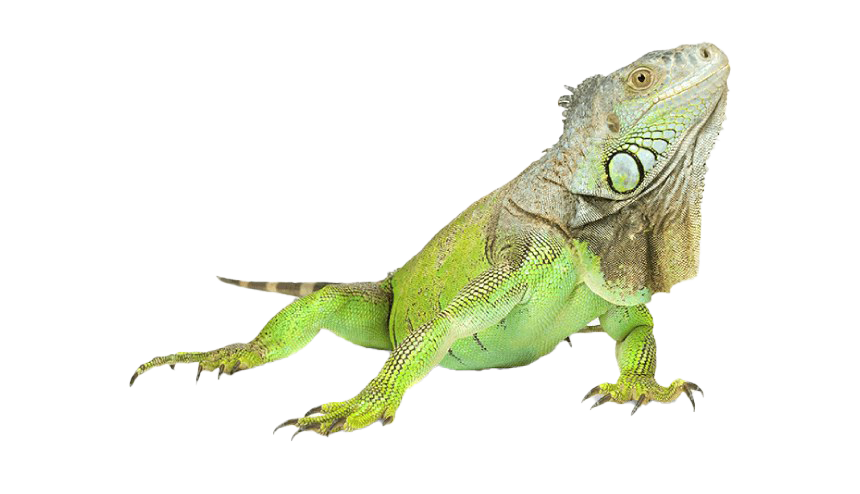
This image has format transparent PNG with resolution 860x494.
You can download this image in best resolution from this page and use it for design and web design.
Iguana PNG with transparent background you can download for free, just click on download button.
Iguana is a genus of herbivorous lizards that are native to tropical areas of Mexico, Central America, South America, and the Caribbean. The genus was first described in 1768 by Austrian naturalist Josephus Nicolaus Laurenti in his book Specimen Medicum, Exhibens Synopsin Reptilium Emendatam cum Experimentis circa Venena. Three species are included in the genus Iguana: the green iguana, which is widespread throughout its range and a popular pet, the Lesser Antillean iguana, which is native to the Lesser Antilles, and the Saban black iguana, which is native to the Caribbean islands of Saba and Montserrat. The latter two species are endangered due to habitat destruction, introduced feral predators, hunting, and hybridization with introduced green iguanas.
The word "iguana" is derived from the original Taino name for the species, iwana. In addition to the two species in the genus Iguana, several other related genera in the same family have common names of the species including the word "iguana".
Iguanas can range from 1.5 to 1.8 metres (5 to 6 ft) in length, including their tail. The two species of lizard within the genus Iguana possess a dewlap and a row of elongated scales running from the midline of their necks down to their tails. Iguanas have varying types of scales covering different areas of their body, for example, there are some large round tuberculate scales scattered around the lateral region of the neck among smaller, overlapping scales. The scales on the dorsal trunk of their body are also thicker and more tightly packed than those on the ventral side. These scales may be a variety of colors and are not always visible from close distances. They have a large round scale on their cheeks known as a sub-tympanic shield.
Iguanas have keen vision and can see shapes, shadows, colors, and movement at long distances. Their visual acuity enables them to navigate through crowded forests and to locate food. They employ visual signals to communicate with other members of the same species.
The tympanum, the iguana's eardrum, is located above the sub-tympanic shield (or "ear shield") behind each eye. Iguanas are often hard to spot, as they tend to blend into their surroundings and their coloration enables them to hide from larger predators.
Like most reptiles, an iguana has a three-chambered heart with two atria, one ventricle, and two aortae with a systemic circulation. The muscles of an iguana are very light in color, this is due to the high proportion of fast glycolytic muscle fibers. These fibers are not very vascularized and are low in myoglobin, giving them their pale look. This high density of fast glycolytic muscle fibers allows iguanas to move very quickly for a short period of time, which facilitates short bursts of movement but is inefficient for long duration movement, since cellular respiration in fast glycolytic muscle fibers is anaerobic.
Male iguanas, like other male examples of Squamata, have two hemipenes. During copulation one hemipene will be inserted into the female's cloacal vent. Females can store sperm from previous mates for several years to continue to fertilize her eggs in case she finds no male within her territory when she is ready to lay again.
Iguanas tend to follow a promiscuous or polygynadrous mating style during the dry season. Mating during the dry season ensures that their offspring will hatch during the wet or rainy season when food will be more plentiful. Females control large territories where they make several nests. Males compete amongst each other for the females in an area and mark their won territory with a pheromone secreted from the femoral pores on the dorsal side of their hind limbs. Male behavior during sexual competition involves head bobbing, extending and retracting their dewlap, nuzzling and biting the necks of females, and on occasion, changing color. Once a female chooses a male, he will straddle the female and hold her in place by biting onto her shoulder, which sometimes leaves scars on females. After copulation, eggs are laid within several nests and allowed to incubate. This low level of parental intervention with their offspring makes iguanas an example of r-strategy reproduction.
Iguanas have historically featured in the culinary traditions of Mexico and Central America. Iguana meat is also consumed in parts of the United States and Puerto Rico. Also, the eggs of iguana are consumed in some parts of Latin America, such as Nicaragua and Colombia.
In this clipart you can download free PNG images: Iguana PNG images free download